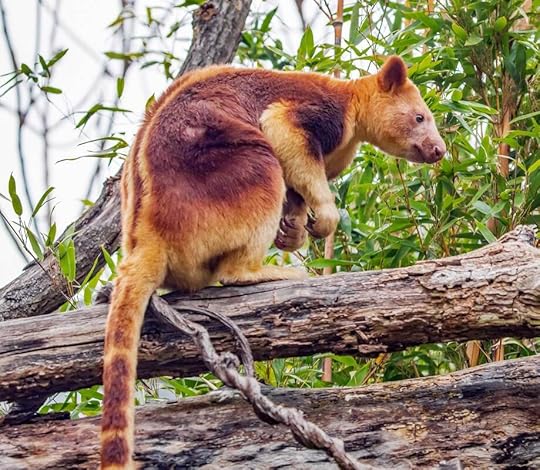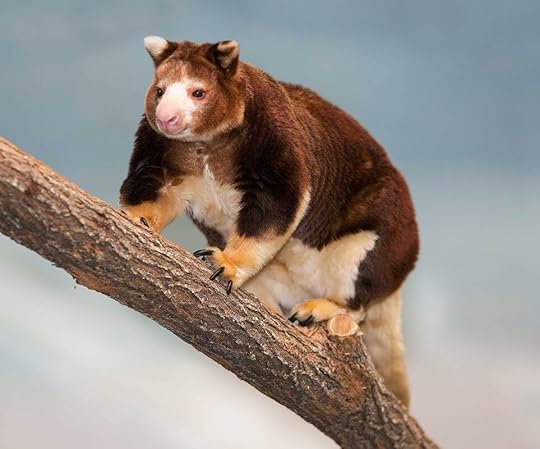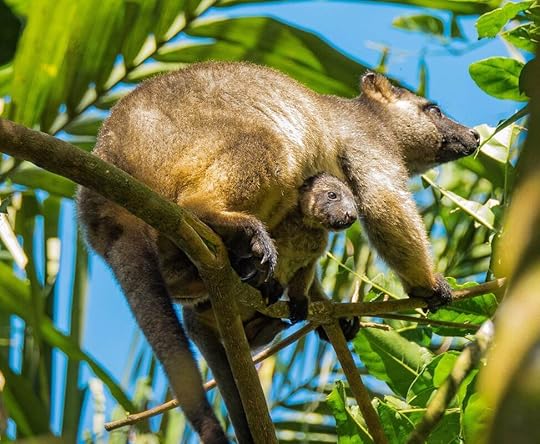Tree Kangaroos - Info you never knew you needed
I've decided far too many people are unfamiliar with tree kangaroos. I intend to fix this problem. Tree kangaroos have been on my mind lately because I've been re-editing my Diffusion series for an audiobook narrator. A major character throughout the series is Mbaiso, a tree kangaroo with mysterious capabilities and intellect. Indeed, Mbaiso is not exactly what he seems to be.
Tree kangaroos are, however, real animals, and since they are under-appreciated, I'll give you a fun overview of these amazing creatures.
Yes, tree kangaroos are real! They live on the island of New Guinea, but also in very northern Australia and some of the Indonesian islands. Why are tree kangaroos so cool? Because they’re kangaroos—that live in trees. When Australian Aborigines and Papuan (New Guinea) natives told early European explorers about tree kangaroos, the explorers refused to believe the stories. You have to admit it seems pretty unlikely, right?
The first photo is a Goodfellows tree kangaroo.
Tree kangaroos are marsupials, in the genus Dendrolagus. There are about 14 different species, but this is one of very few types of large mammals with species still being discovered. Most tree kangaroos are about the size of a house cat. They are a fascinating example of divergent evolution (when groups of similar creatures become isolated and gradually diverge in form and function). Long ago, groups of ground-dwelling kangaroos became isolated in areas of dense tropical forest, as opposed to the open grasslands more typical for kangaroos. Once isolated in rainforest areas, they evolved the ability to climb trees.
These creatures eat, sleep, and breed in the treetops, but that doesn’t mean they live a comfortable existence. After all, breeding in the treetops might require some caution, right? Also, they're a tasty meal for their primary predator, the amethystine python (which has a habit of hugging much too tightly). And... natives hunt tree kangaroos for food In New Guinea: "The man who has successfully hunted a tree-kangaroo has greatness bestowed upon him. He has conquered the largest, most prestigious and human-like marsupial known to his people." (Tim Flannery, from the awesome book, Throwim Way Leg). And finally, they depend on pristine rainforest, and if you haven’t heard, rainforests are getting smaller every day (a real bummer).
Tree kangaroos are reclusive. Some are extremely rare and live in places so remote that they are unusually tame, as they have never learned to fear humans. Just a few years ago, National Geographic published an article about the Wondowoi Tree Kangaroo, a species that had not been spotted since 1929 (almost a hundred years ago). It was thought to be extinct, until an amateur botanist led an expedition into the nearly-impenetrable bamboo forests of the Wondiwoi Mountains of West Papua to find it. After much searching, he took the first ever photographs of this species.
The Papuan people of New Guinea have numerous ancient myths about tree kangaroos, some of which play a role in the Diffusion novels. For example, Mbaiso's name comes from a rare tree kangaroo, Dingiso mbaiso, which is revered by the local Moni people as an ancestor. When describing encounters with these animals, the tribesmen hunters say the creatures sit up, whistle, and hold up their paws in greeting. So the Moni believe the creatures are ancestor spirits who recognize them.
Another interesting story, this one about the Matschie’s Tree Kangaroo, is that the creature has a special power. If you think of the girl you love before you let your arrow fly to shoot this tree kangaroo, at the moment the arrow pierces the animal’s body, that’s when the girl will fall in love with you.
The second photo is the Matschie's tree kangaroo.
Tree kangaroos really are adapted to life in the trees. Compared to ground kangaroos, they have longer, curved nails for gripping the bark. Their hind feet are longer, and they have spongy, padded grips on their palms and the soles of their feet. Perhaps most striking is their tail. It is longer and heavier than those of ground kangaroos, which gives them better balance as they climb. When they climb straight up a tree trunk, they wrap their forearms around the tree and use their powerful hind legs to "hop" up the tree.
They are terrific jumpers. They can leap from one branch to another that is thirty feet (9m) below them. And, this may be hard to believe, but they can leap to the ground from as high as sixty feet (19m) without getting hurt! Considering adults can weigh 25 to 30 pounds (11 to 14kg), this is astounding.
As mentioned above, tree kangaroos are marsupials. You know what that means, right? It means they give birth to their babies very early, and then the babies develop in an external pouch. The babies are only the size of jellybeans at birth. At that point, the only parts of their external anatomy that are well developed are their hands and mouth. They use their hands to crawl to the pouch, then they attach their mouth to a nipple and hang on—for a long time. Astoundingly, baby tree kangaroos stay in the mother's pouch for up to 275 days. And then, after they come out, they are not weaned for up to another 240 days!
The third photo is a Bennett's tree kangaroo with a large baby, getting almost too big to fit in her pouch.
There you go. Now you can regale your friends with your tree kangaroo knowledge.



Photo Credits:
- Goodfellow's tree kangaroo - DepositPhotos
- Matchie's tree kangaroo - DepositPhotos
- Bennett's tree kangaroo with baby in pouch - DepositPhotos
Tree kangaroos are, however, real animals, and since they are under-appreciated, I'll give you a fun overview of these amazing creatures.
Yes, tree kangaroos are real! They live on the island of New Guinea, but also in very northern Australia and some of the Indonesian islands. Why are tree kangaroos so cool? Because they’re kangaroos—that live in trees. When Australian Aborigines and Papuan (New Guinea) natives told early European explorers about tree kangaroos, the explorers refused to believe the stories. You have to admit it seems pretty unlikely, right?
The first photo is a Goodfellows tree kangaroo.
Tree kangaroos are marsupials, in the genus Dendrolagus. There are about 14 different species, but this is one of very few types of large mammals with species still being discovered. Most tree kangaroos are about the size of a house cat. They are a fascinating example of divergent evolution (when groups of similar creatures become isolated and gradually diverge in form and function). Long ago, groups of ground-dwelling kangaroos became isolated in areas of dense tropical forest, as opposed to the open grasslands more typical for kangaroos. Once isolated in rainforest areas, they evolved the ability to climb trees.
These creatures eat, sleep, and breed in the treetops, but that doesn’t mean they live a comfortable existence. After all, breeding in the treetops might require some caution, right? Also, they're a tasty meal for their primary predator, the amethystine python (which has a habit of hugging much too tightly). And... natives hunt tree kangaroos for food In New Guinea: "The man who has successfully hunted a tree-kangaroo has greatness bestowed upon him. He has conquered the largest, most prestigious and human-like marsupial known to his people." (Tim Flannery, from the awesome book, Throwim Way Leg). And finally, they depend on pristine rainforest, and if you haven’t heard, rainforests are getting smaller every day (a real bummer).
Tree kangaroos are reclusive. Some are extremely rare and live in places so remote that they are unusually tame, as they have never learned to fear humans. Just a few years ago, National Geographic published an article about the Wondowoi Tree Kangaroo, a species that had not been spotted since 1929 (almost a hundred years ago). It was thought to be extinct, until an amateur botanist led an expedition into the nearly-impenetrable bamboo forests of the Wondiwoi Mountains of West Papua to find it. After much searching, he took the first ever photographs of this species.
The Papuan people of New Guinea have numerous ancient myths about tree kangaroos, some of which play a role in the Diffusion novels. For example, Mbaiso's name comes from a rare tree kangaroo, Dingiso mbaiso, which is revered by the local Moni people as an ancestor. When describing encounters with these animals, the tribesmen hunters say the creatures sit up, whistle, and hold up their paws in greeting. So the Moni believe the creatures are ancestor spirits who recognize them.
Another interesting story, this one about the Matschie’s Tree Kangaroo, is that the creature has a special power. If you think of the girl you love before you let your arrow fly to shoot this tree kangaroo, at the moment the arrow pierces the animal’s body, that’s when the girl will fall in love with you.
The second photo is the Matschie's tree kangaroo.
Tree kangaroos really are adapted to life in the trees. Compared to ground kangaroos, they have longer, curved nails for gripping the bark. Their hind feet are longer, and they have spongy, padded grips on their palms and the soles of their feet. Perhaps most striking is their tail. It is longer and heavier than those of ground kangaroos, which gives them better balance as they climb. When they climb straight up a tree trunk, they wrap their forearms around the tree and use their powerful hind legs to "hop" up the tree.
They are terrific jumpers. They can leap from one branch to another that is thirty feet (9m) below them. And, this may be hard to believe, but they can leap to the ground from as high as sixty feet (19m) without getting hurt! Considering adults can weigh 25 to 30 pounds (11 to 14kg), this is astounding.
As mentioned above, tree kangaroos are marsupials. You know what that means, right? It means they give birth to their babies very early, and then the babies develop in an external pouch. The babies are only the size of jellybeans at birth. At that point, the only parts of their external anatomy that are well developed are their hands and mouth. They use their hands to crawl to the pouch, then they attach their mouth to a nipple and hang on—for a long time. Astoundingly, baby tree kangaroos stay in the mother's pouch for up to 275 days. And then, after they come out, they are not weaned for up to another 240 days!
The third photo is a Bennett's tree kangaroo with a large baby, getting almost too big to fit in her pouch.
There you go. Now you can regale your friends with your tree kangaroo knowledge.



Photo Credits:
- Goodfellow's tree kangaroo - DepositPhotos
- Matchie's tree kangaroo - DepositPhotos
- Bennett's tree kangaroo with baby in pouch - DepositPhotos
Published on August 14, 2025 11:34
No comments have been added yet.



